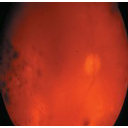1- HIV Etiology:
* Proliferative Diabetic Retinopathy
* Occlusion of the central vein of the ischemic form of retinal
* Retinal Tear
* Terson syndrome (HIV associated with subarachnoid hemorrhage)
* Eales disease
* Before a subconjunctival hemorrhage spontaneous water, always think of intraocular foreign bodies unnoticed;must also sought hypertension.
* Small ulcers spread to the cornea (superficial punctate keratitis = KPS) -> adenovirus keratitis and dry eye syndrome.
* Herpetic keratitis: dendritic ulcer or geographical map
* Blepharospasm: consequence of acute keratitis
* Keratitis neuroparalytic: dystrophic keratitis secondary to corneal anesthesia (inocclusion eyelid and facial palsy).
* Hypopion: purulent fluid level in the anterior chamber
* Ankylosing spondylitis is associated with recurrent anterior uveitis of character and good prognosis.
* Disease Still gives severe uveitis is associated with cataracts and keratitis in strip.
* The neovascular glaucoma gives a similar picture with acute angle-closure glaucoma.
* Episcleritis: red and painful eye without loss of visual acuity (pain seems to tell the instillation of a vasoconstrictor eye drops).
* Ocular hypertension is defined by a pressure> 21 mmHg (the average is 16 mmHg).
* Ocular hypertension is not synonymous with glaucoma All hypertonia ocu-lar do not cause glaucoma; there are open-angle glaucomas which the intraocular pressure is within the normal limits.
* Kinetic perimetry (Goldmann perimeter); static perimetry (perimeter Friedmann).
* Congenital glaucoma: occurs in the first 6 months megalocornea, tearing and photophobia. Evolution towards buphthalmos -> blindness Surgical treatment (goniotomy Barkan; trabeculectomy) …
* Terson syndrome: vitreous hemorrhage associated with subarachnoid hemorrhage.
* Hyalite: vitreous inflammatory disorder in posterior uveitis (toxoplasmosis).
* During the occlusion of the central artery of the retina, the fovea keeps its color as it is vascularized by the choroid.
* The total power of convergence is about 60 diopters
* Amblyopia: This is the state of decreased visual acuity functional or organic
* Much of the development of the world is done during the first two years of life, which is why emmetropia is reached around age 2 or 3 years
* The loss of accommodative power was established about 45 years and became full to 65
* Floater: floaters
* Presbyopia will be seen later in myopia
* Ultrasound B is always indicated when the retina is not visible (HIV) to remove a retinal detachment.
* Visual Eclipses for a few seconds papilledema of HIC
* Foster-Kennedy syndrome is unilateral optic atrophy with papilledema on the other side (brain tumor + HIC)
* HIC -> bilateral involvement of VI above
* Pilocarpine: miotic (sympathomimetic)
* Indications mydriatic eye drops, to prevent or break the adhesions; put to rest the eye (uveitis, keratitis).
* Scopolamine is an anticholinergic -> mydriatic
* The first histological lesions of diabetic retinopathy is the thickening of the basement membrane, loss of pericytes and endothelial cell loss of retinal capillaries => obstruction, microanévrisme.
* The cotton wool spots (dysoriques nodules): superficial white lesions and small sizes; they correspond to the axoplasmic material accumulation in optical fibers. They reflect the retinal artery occlusion precapillary.
2- Anterior uveitis:
* Red eye; Rating Decrease in visual acuity and moderately deep pain
* Circle périkératique; normal corneal transparency
* Pupil in miosis sometimes or posterior synechiae iridocristalliniennes with pupillary distortion.
* Slit Lamp: Tyndall phenomenon (proteins and cells in the aqueous humor) + precipitate rétrocornéen
* The FO is systematic review looking for posterior uveitis
* Causes include ankylosing spondylitis; herpes; Still’s disease; sarcoidosis, Behcet disease (+ hyalite; + hypopyon).
* Treatment: mydriatic eye drops + topical corticosteroids.
3- Secondary Glaucoma:
A- Traumatic:
Significant hyphema; lens dislocation
B- Achievement of the uvea:
– Uveitis hypertensive
– Chronic Uveitis (pupillary seclusion?)
C- vasculopathies:
– Increasing the episcleral venous pressure (pulsatile exophthalmos; mediastinal tumors orbital tumors ….)
– Thrombosis of central retinal vein (glaucoma 100th day)
– Rubeosis iris diabetic.
D- ocular tumors:
Choroidal hemangioma (Sturge Weber); choroidal melanoma …
E- Drugs:
Long-term corticosteroid
Note:
HIV = intraocular vitreous hemorrhage




Leave a Reply